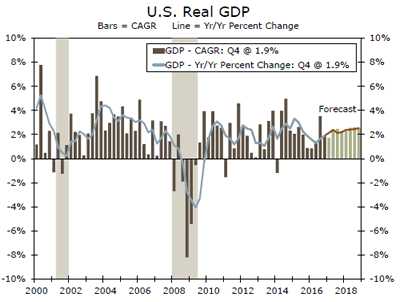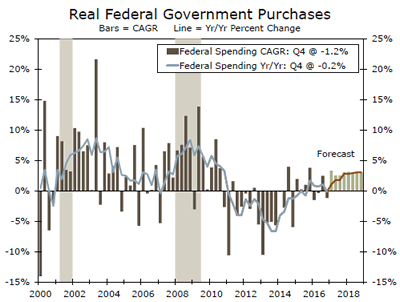U.S. Review
Light Data Week as We Wait for Fed Policy Clarity
- The economic data were on the lighter side this week. JOLTS, import prices and the trade balance were key pieces of new information and continued to support a positive assessment of the domestic economy.
- We updated our economic outlook for the medium term; we see growth of 1.7 percent in Q1, 2.2 percent for 2017 as a whole and 2.4 percent in 2018. There is considerable uncertainty regarding fiscal policy outcomes, but we doubt they will meaningfully play out in the economy before next year.
Economy on Solid Ground, Outlook Is Up in the Air
Our outlook for 2017 remains on track as a relatively light data calendar offered no red flags on the domestic economy. We released our updated forecast this week, in which we left our 2017 outlook largely unchanged. We do not anticipate fiscal policy changes, whatever they turn out to be, to materialize in the economy until 2018 at the earliest. We recognize the considerable uncertainty around our forecast, and published a report outlining the assumptions on which our current outlook was formulated, titled Fiscal Policy & Our Economic Outlook, available on our website. We will update our thinking as more clear policy actions come to light.
The economic calendar was sparse this week. The Job Openings and Labor Turnover Survey (JOLTS) continued to show healthy labor market dynamics in December, international trade figures highlighted strong domestic demand to end 2016 and import prices edged higher in January as the drag from low oil prices continued to abate.
Job openings essentially held steady to end the year while hires increased slightly, according to the December JOLTS (top chart). The report reiterated that the U.S. labor market is on solid footing. Hiring, openings and layoffs in December were essentially unchanged from the previous month, though there were fewer quits. A rise in quits suggests rising wages may follow as workers tend to switch jobs at a higher pay rate. Fewer quits in December may have played a role in the disappointing wage growth recorded in the January jobs report. Still, the labor market is well suited for job switchers in 2017. At the same time, the tight labor market is encouraging employers to hold on to their employees. Layoffs are becoming less frequent, as evidenced by low levels of new applications for unemployment insurance. Jobless claims unexpectedly dropped last week to its lowest point since mid-November. Post-election optimism may have also played a role in the recent drop in layoffs. Regardless, the current state of the job market bodes well for personal consumption and income this year as companies offer better pay and incentives to attract and retain workers.
International trade is a major variable. We did not include changes to trade policy in our outlook, as we need to wait and see how the administration chooses to approach policy. We did push up our forecast for U.S. import growth due to strong growth in domestic demand, which made net exports a slightly larger drag on overall GDP growth. International trade figures out this week support that notion. Strong import and export growth in December highlighted both domestic demand and improving global economic conditions, particularly given that exports surged despite the strong dollar headwind. Firming global demand is but one more encouraging signal for the U.S. factory sector that has accumulated in recent months.
Import prices jumped 0.4 percent in January and 3.7 percent over the year as fuel prices firmed. Excluding fuels, import prices were down 0.2 percent in January and flat over the year (bottom chart). The stronger dollar continued to benefit U.S. purchasers of products from overseas. We expect this to continue as the dollar rises further this year.
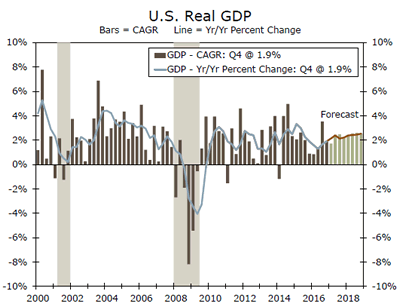
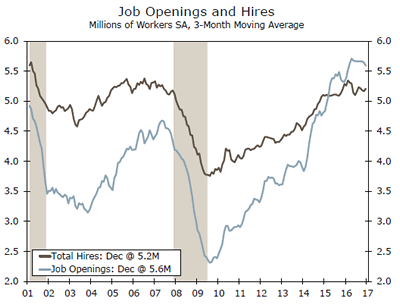
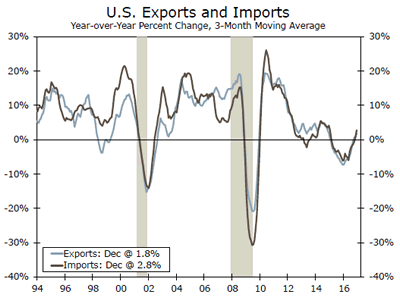
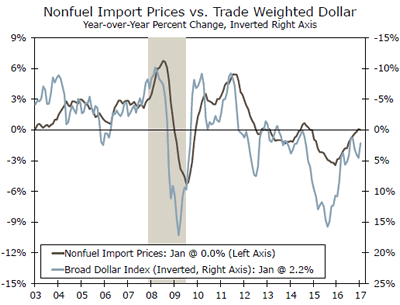
U.S. Outlook
Retail Sales • Wednesday
On the back of steady labor market conditions and gradually increasing income growth, headline retail sales posted its ninth straight positive monthly reading in December. Headline retail sales were boosted by a surge in vehicle and online sales in December, while restaurant and department store sales, among others, languished during the month. Core retail sales, which feed directly into the real GDP calculation, eked out a modest monthly reading dragging down the quarterly average, which is consistent with the softer real consumer spending figure in Q4. Consumer outlays remain behind the unsustainable post-election jump in sentiment. In January, weak manufacturer unit auto sales and a dip in average retail gasoline prices should pull down the headline nominal retail sales reading. That said, the underlying trend remains positive and we expect real consumer spending to increase 2.7 percent in 2017 and 2018.
Previous: 0.6% Wells Fargo: 0.1% Consensus: 0.1% (Month-over-Month)
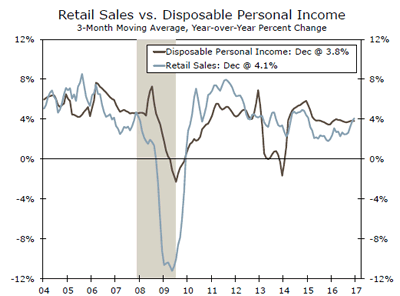
Industrial Production • Wednesday
Following a weak November reading, industrial production rose 0.8 percent in December largely reflecting a weather-related bounce in utility output. Much of the surge in utilities is expected to be reversed in January due to a swing in temperature from a slightly cooler December (measured in the monthly deviation in heating degree days) to an unusually mild January, which reduced demand for heating energy. The pullback in heating demand will also likely constrain consumer spending on energy services. At 56, the ISM manufacturing index in January climbed to its highest level since November 2014, marking the fifth-straight month in expansion territory. Regional purchasing manager indexes were also positive in January. That said, some of the gain will likely be dampened by a calendar quirk as manufacturing hours worked, which are factored into the early output estimate, are typically understated when the 15th payday falls after the survey week.
Previous: 0.8% Wells Fargo: 0.1% Consensus: 0.0% (Month-over-Month)
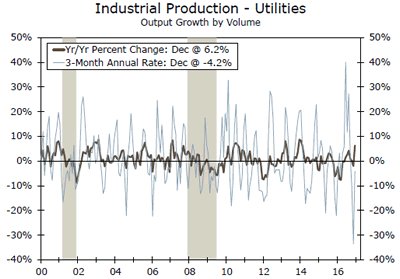
Housing Starts • Thursday
Thanks to an outsized surge in the volatile multifamily component, housing starts ended 2016 on a solid note, rising to a 1.226 millionunit pace in December from an upwardly revised 1.102 million-unit rate in November. Although the strong reading is welcome, the level of starts is a bit exaggerated, especially due to seasonal factors and weather distortions. Permits, which are less volatile on a monthly basis, were also weak, but the entire drop was concentrated in multifamily. With the level of permits running a bit behind starts, any payback from December’s strong reading will likely be muted. The NAHB/Wells Fargo Housing Market Index remained at an elevated level in January, suggesting some upside risk to overall starts. Although builder sentiment is typically seen as a forward-looking indicator for starts, the 11-year high in December and still-elevated reading in January seems to be somewhat unbridled and could also reflect some election euphoria.
Previous: 1,226K Wells Fargo:1,209K Consensus: 1,230K
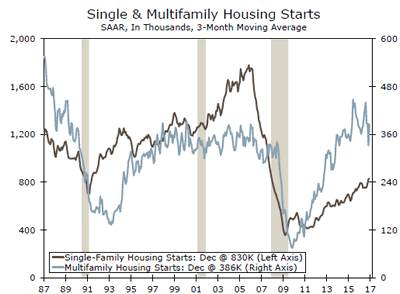
Global Review
Update on NAFTA Trading Partners
- The Mexican peso has depreciated sharply versus the U.S. dollar since Election Day, which has contributed to the sharp rise in Mexican CPI inflation in the past two months. The Bank of Mexico hiked its main policy rate by 50 bps this week in an attempt to keep inflationary expectations in check.
- In Canada, the stabilization in oil prices has caused the trade account to swing back into a small surplus after two years of red ink. Employment growth has been strong in recent months, but the Bank of Canada continues to maintain a cautious approach to policymaking.
Update on NAFTA Trading Partners
The Mexican peso has been one of the worst performing currencies vis-à-vis the U.S. dollar over the past year or so. Not only did the peso get caught in the downdraft that affected most emerging market currencies versus the greenback last year, but uncertainties related to the Trump administration’s future policies toward Mexico have weighed on the peso in the past three months. Between Election Day and Inauguration Day the peso plunged more than 15 percent against the dollar. Although the Mexican currency has recouped some of its losses in the past two weeks, it remains about 10 percent below its level on Election Day.
Data released this week showed that the overall CPI inflation rate shot up to 4.7 percent in January, the highest year-over-year rate in four years (top chart). Although some of the surge in inflation reflects the recent increase in the governmentally controlled price of gasoline, the sharp decline in the value of the peso is directly contributing to the inflationary impulse in the Mexican economy.
Therefore, it came as little surprise that the Bank of Mexico raised its main policy rate by 50 bps on Thursday in an effort to keep inflationary expectations in check. The central bank has hiked its main policy rate by 325 bps since December 2015 (see chart on front page). In our view, the combination of policy tightening, higher inflation, and uncertainty related to the future of NAFTA will produce a mild recession in Mexico this year, despite some acceleration in global economic activity.
As noted above, the Mexican peso has regained some of its footing after falling to an all-time low against the U.S. dollar in mid-January. Our currency strategy team looks for the peso to remain on the defensive—they acknowledge it could sustain further near-term losses—but look for it to regain its footing further out as policy uncertainty starts to dissipate.
Moving north of the border, Canada is starting to incur small trade surpluses again after two continuous years of red ink in its trade accounts (middle chart). Yes, the black ink in the past two months is nowhere near the surpluses that were registered in the middle years of the last decade when commodity prices were sky high. But it appears that bleeding has largely come to an end now that oil prices have stabilized.
There was more good news for Canada this week in the form of the employment report, which showed non-farm payrolls rising by 48K in January. Not only was the outturn much stronger than expected, but it follows on the heels of the 54K jobs that were created in December. Canadian employment figures can be notoriously volatile on a monthly basis, but the trend is clearly up (bottom chart). The unemployment rate, which edged up to 7.2 percent at the beginning of 2016, has trended lower to 6.8 percent presently.
That said, the Bank of Canada (BoC) is maintaining a cautious approach to policymaking citing "significant slack in the labour market." In our view, the BoC will remain on hold through most of 2017. In the context of modest Fed tightening this year, our currency strategy team looks for some depreciation of the Canadian dollar versus the greenback in the near term.
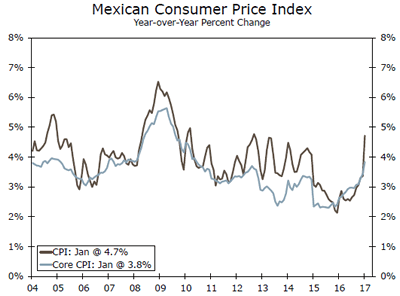
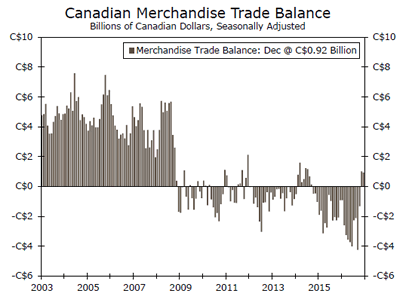
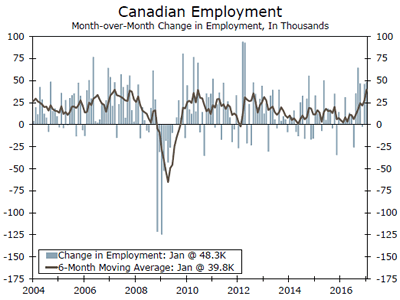
Global Outlook
Germany ZEW • Tuesday
After the weak number on German industrial production for December reported this week, Germany is going to release the ZEW current situation and expectations index for February on Tuesday. It will be interesting to see how this week’s release of the lowerthan- expected industrial production index changes current expectations on the conditions of the German economy. January’s ZEW current situation index reading was very strong, at 77.3, up from a 63.5 print in December, but this measure can come down fast if analysts believe the economy was weaker than they thought.
Meanwhile, the expectations component of the ZEW survey was also higher in January. While this expectations component looks forward rather than backwards, it may not be as affected as the current situation index. However, we believe that the importance of the industrial sector in Germany is such that a lower ZEW reading is probably in the cards for next week.
Previous: 16.6 Consensus (Expectations Index): 15.0
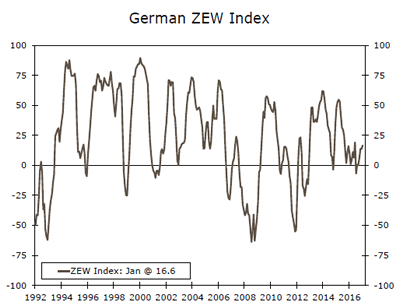
Eurozone Industrial Production • Tuesday
The Eurozone industrial production index for December is on the docket for next week and our expectation, and the market’s expectation, is that it is going to be weak as indicated by the weak reading of the German industrial production index released this week.
At the same time, the Eurozone is expected to release the ZEW survey expectations index for February, an index that has also been slowly increasing over the past five months, to reach 23.2 in January from 18.1 reading in December. Meanwhile, construction activity in December is on the docket for Friday. This index has been weakening on a year-over-year basis since mid-2016 to close November at 0.0 percent, year over year. However, after a very weak September reading, down 0.8 percent, the index posted two consecutive increases of 0.4 percent in October and November.
Previous: 1.5% Consensus: -1.5% (Month-over-Month)
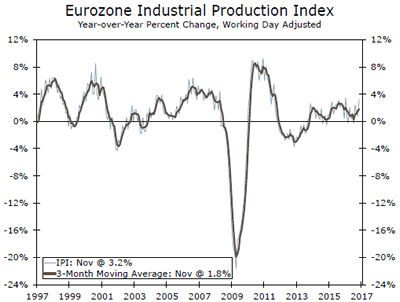
Brazil Economic Activity • Thursday
Brazil will release its monthly economic activity index on Thursday to end a year to forget, a year that marks the first time in recorded Brazilian economic history when the economy managed to decline for two consecutive years. We may say that this is the Brazilian version of a "black swan," an event that is almost unthinkable, but that has finally come to fruition.
But, what has made this recession even more damaging for Brazil has been the political impeachment of the elected president Dilma Rousseff in mid-2016 as well as the discoveries of several corruption/fraud schemes that went on for a long time and negatively affected the reputation of Brazilian companies and politicians all across the political spectrum. Furthermore, the corruption/fraud accusations have also tainted politicians all across Latin America, with implications that could linger for a long time.
Previous: 0.2% (Month-over-Month)
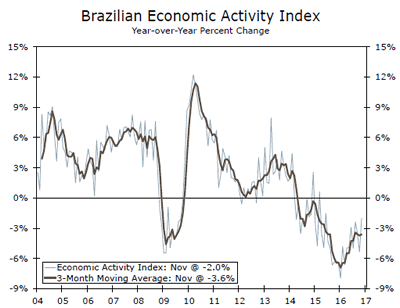
Point of View
Interest Rate Watch
Financial Markets Under Policy Uncertainty
Our outlook for inflation, interest rates and the dollar is composed under the cloud of uncertainty that is current public policy in Washington. Meanwhile, private sector actors act in anticipation of policy moves. Recently, stronger employment and ISM manufacturing data signal economic improvement.
Our outlook is for stronger economic growth in 2017 relative to 2016. In particular, we suspect business investment will be a key factor in the turnaround from 2016. In part, this stronger business spending will likely reflect higher energy prices and an easing of regulatory policy in general and financial regulation in particular, as financial institutions will likely find fewer barriers to lending to businesses, households and home builders. With stronger demand and given the limited ability of supply to respond in the short-run, we anticipate an upward bias to inflation in 2017 and 2018 (top graph). With stronger economic growth and higher inflation, the outlook is for slightly higher interest rates (middle graph). We anticipate that the Fed will raise the funds rate twice in 2017 and that nominal yields will increase to compensate for the higher rate of inflation. The extent of any increase in interest rates will be moderated by the extent of capital inflows into the U.S. For some time now, the American economy has benefitted from both direct (commercial real estate) and financial flows (purchases of U.S. Treasury, corporate and agency debt).
Easier fiscal policy via tax cuts and more defense/infrastructure spending as well as tighter monetary policy via the Fed raising the funds rate will give rise to an increase in the value of the dollar (bottom graph). Market Interactions in the Outlook Moving forward, the outlook reflects the interaction in the markets for goods, credit and foreign exchange. Given the high level of uncertainty in policy in all of these areas, we remain vigilant in our recognition that changes in one area will make a difference in all areas of the real economy and financial assets. These market interactions are often glossed over by many commentators when they focus on one area alone, but these interactions form the basis for thoughtful decision making in the macro economy.
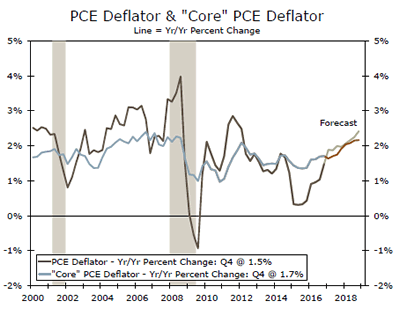
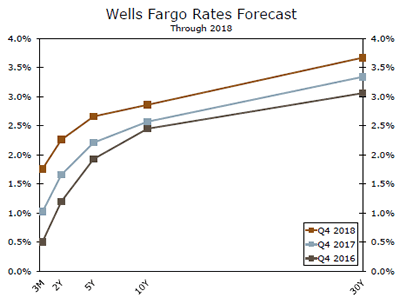
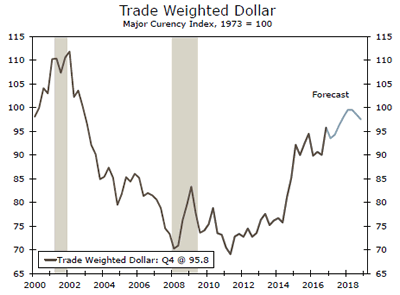
Credit Market Insights
Fewer Credit Card Swipes
Credit data, released by the Federal Reserve earlier this week, showed that consumers did not use their credit cards as much during the December holiday season. Consumer credit increased by a slowerthan- expected $14.2 billion, missing expectations for a $20 billion gain. For the year, consumer credit was up 6.4 percent— the slowest pace since 2013. It is also worth noting that the Fed’s consumer credit report does not include debt secured by real estate.
Most of the credit growth in recent years has been nonrevolving, which includes education and auto loans. However, the pace of growth has started to slow as auto loan standards have tightened and tuition increases slowed. Meanwhile, revolving credit, which is mostly credit cards, remains below its pre-recession peak, rising 2.9 percent year over year in December, down from the 14.4 percent pace in November. It appears as though consumers remain cautious and are being selective with their credit.
Nonetheless, household spending continues to be a driving force behind economic growth. With consumer confidence at a cycle-high, a strengthening labor market and a pickup in wage growth, we expect real personal consumption to increase 2.7 percent in 2017 and 2018. Consumers could also see some help from the proposed income tax decreases, which could provide a further boost to spending in 2018.
Topic of the Week
Fiscal Policy and Our Economic Outlook
With the release of our February Monthly Economic Outlook, we have incorporated a set of fiscal policy assumptions based on what we think is the most likely outcome based on policy proposals from President Trump and senior congressional leaders. While we recognize the challenges of forecasting policy in the current environment, we believe these assumptions provide the most realistic baseline scenario that we will tweak in the months ahead as new developments unfold.
The fiscal policy assumptions in our outlook include: an increase in defense spending, the repeal of the Affordable Care Act (ACA) and related taxes, individual income tax cuts and corporate tax cuts. At this time, we do not see a path for additional infrastructure spending, although some tax breaks for infrastructure projects are expected. Combined, these assumptions lead to our estimate of a federal budget deficit of $650 billion for federal fiscal year 2017 and $950 billion for fiscal year 2018. On net, we downwardly revised our 2017 real GDP growth forecast by 0.1 percentage point, but we have adjusted our 2018 real GDP growth forecast upward by 0.2 percentage points.
Our 2018 forecast includes a boost to both real consumer spending and real business fixed investment, but some of this boost to domestic demand is offset by greater import growth. Should policymakers decide to make offsetting cuts to government spending to finance tax cuts, the net effect on the deficit and, by extension, GDP growth in the near term would be much smaller.
In short, we continue to expect a wide range of possible policy outcomes but have settled on the changes to the ACA, along with cuts to individual and corporate taxes without the major tax "reforms" sought by the Ryan blueprint. We will continue to monitor and report fiscal policy development and should proposed legislation deviate from our baseline assumptions, we will revise our forecast accordingly. For further reading, see our report, Fiscal Policy & Our Economic Outlook, which is available on our website.
